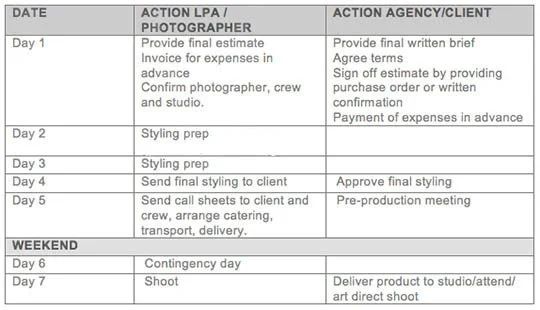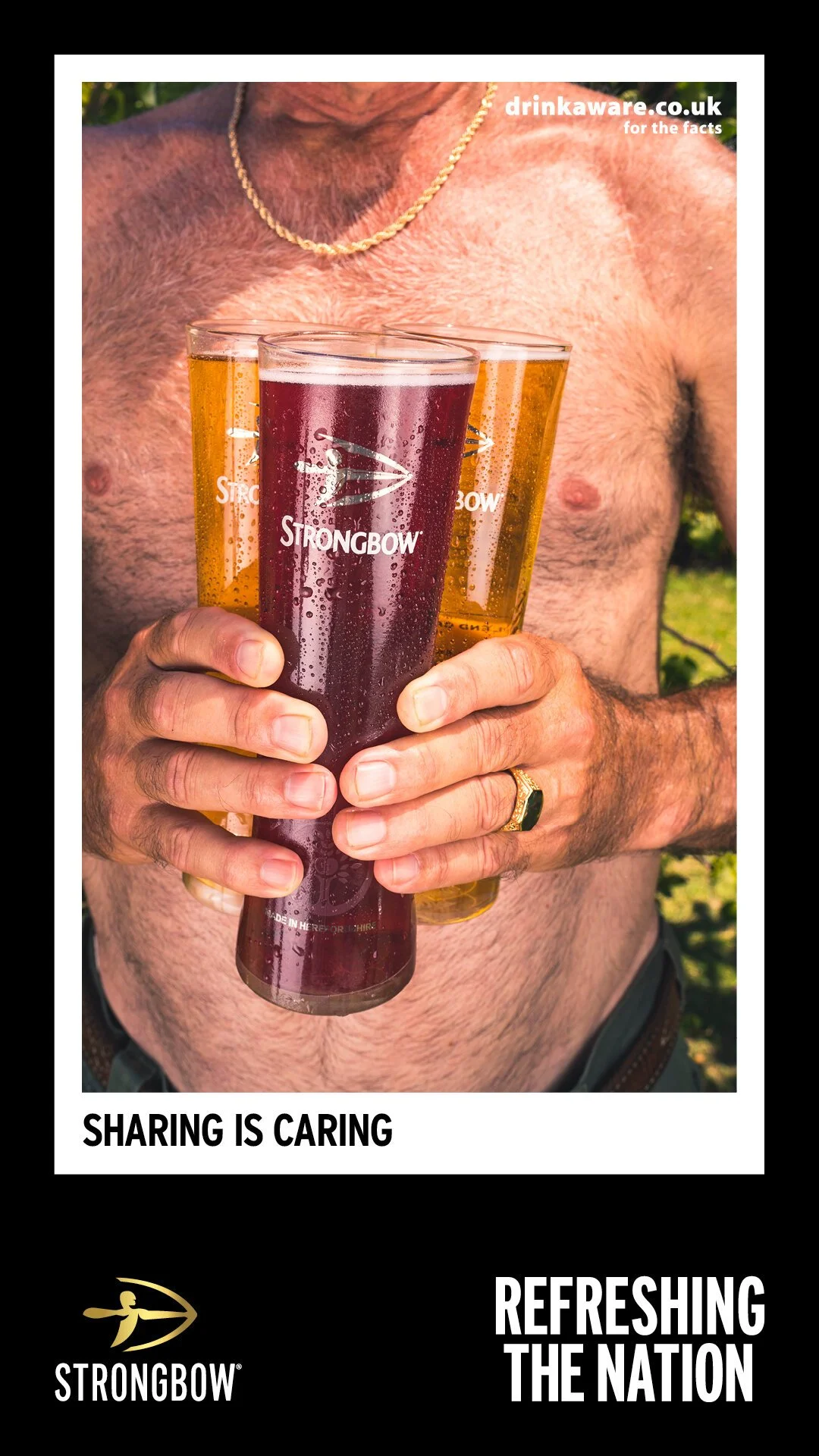How to Commission a Photographer / Part 5: Timings
Part 5: Timings: The production process.
As part of our ten-part, weekly series on commissioning photography, we are now going to look at the shoot production process - from budget sign off to the day of the shoot. This will enable you to work out how it fits in with your timings and see what else you might need to be prepared for.
LPA are shoot producers as well as agents and it’s our job to plan and schedule your shoot so everything runs smoothly. The key to that is to think ahead and be realistic about how long things might take, however specific or convoluted things might seem. And actually, the key milestones are exactly the same with every shoot...
Whether the shoot is relatively straightforward still life …
© Alexis Ko / Coffee
or something more complex, involving location permits, model casting and styling…
© Nick David / Natwest
Here’s a quick step-by-step guide from our point of view.
Step One: Agree budget
The first thing we need to do before we crack on with any shoot production or even confirm the photographer for you is to 100% agree on the shoot costs in writing. To do this the brief needs to be the final, confirmed brief. Changes can be a lot more disruptive than you might think (see Part: 3)
As you can hopefully appreciate, once we have agreed to commence with the shoot production we have also agreed to commit to the liability of the shoot costs. We will confirm the photographer and the crew, which means they won’t be available for other shoots so may well turn work away. It is likely we will also start having to pay for other shoot expenses. We often have several shoots going on at the same time, so we do need to be a bit strict here in terms of getting everything pinned down and the budget confirmed in writing, ideally by way of a purchase order.
Step Two: Agree timings
Of course, we will always try and be as flexible as possible, especially if there is little more than the photographer that we need to confirm. Having said that though, to guarantee you are going to get the photographer of your choice when you want them, and for us to confirm the perfect crew, not to mention work out if the timings are even possible, the best plan is to pin the dates down ASAP.
Step Three: Agree contracts
When we send our estimate for the shoot we always attach a set of our terms and conditions. These outline the basic legal terms on which we are happy to do business. You may have a particular photography shoot contract yourself, probably with much of the same clauses that our own terms include, the goal is simply to reach a mutually acceptable and fair business agreement so we can get on with the logistics and the creative part. Our business terms are industry standard and just lay down general guidelines so expectations are met and everything is clear. They include things like payment and cancellation terms, who is liable for third party clearances, what you need to do if you want to extend the agreed usage and a few other things. But lots more about this next week in Part 6: Photoshoot Contracts.
Step Four: Funds
As I mentioned earlier, when we agree to produce a shoot and deliver the required images we agree to take on a financial liability. We can’t, and hopefully, you’ll agree, we shouldn’t bankroll any shoot that is more than just basic photographic expenses. This isn’t just because it will play havoc with our cash flow, it is just too much of a risk to a small business to take on such a large liability should the worst happen and we don’t get paid. We also want to preserve our relationships with our own suppliers that we have spent years building up by avoiding late payment. I think it’s fair to say most photographers and agents would agree. Some productions we deal with have 50k plus budgets associated with them, so you can imagine how the financial liability might accumulate.
Step Five: Plan the schedule
Once all of the above are in place the lead time required for shoots varies depending on what is involved.
A shoot with little necessary preparation for example can be achieved with only 24 hours lead time …
Say for example, you needed a photographer to shoot some of your staff for internal communications. As long as things are organised on your side we can get a photographer to shoot pretty much the next day. Having said that though, it would be preferable for the photographer to do a recce of the location so he can plan some shots.
© Tim Dunk / Roar Studios
The production schedule might look something like this…
If the shoot involves some styling and more prep then we start to factor in more time. For a shoot like this for example…
© Katrina Lawson Johnston / Manolo Blahnik
the production schedule might look something like this…
If the shoot involves casting models or location scouting then we start to factor in more production time.
© Imogen Forte / Strongbow
Based on a three day shoot with similar scenarios, the production schedule might look something like this…
First, we need to confirm and brief all the crew, then we can press on with the casting and location scouting. Next, we need to get the client to ‘sign off’ or approve the models and locations, so this takes at least a week. When we have this all signed off, we can give the model sizes to the stylist who can source the wardrobe. Once we have the location/s approved we know what additional props or set dressing might be necessary and we can get all the location permits processed. Ideally, it’d be great to have three clear weeks for production, mainly because in our experience some clients might take a while to approve all the shoot elements, but it is just about achievable in two.
There are a few other factors that might slow down the production process, here are the main culprits!
• If your shoot requires some child models, we need to get children’s performance licences for example (more about this in Part 7: Photoshoot Legal Obligations). These can take up to ten days.
• Some location permits can take a while, if you need to apply to the local council for a street permit for example we are at the mercy of that particular council.
• Complex set builds or model-making might take around a week.
• Overseas shoots are not only slowed down by a potential obstructive time difference and dealing with a third-party production company but you might also need to factor in additional time to get all the necessary paperwork in order, Visas and Carnets for example.
• Sometimes timings of a shoot are out of our control due to something on your side of things. Maybe an event is happening on a particular day.
Or perhaps someone on the commissioner’s side of things isn’t available, either to be on the shoot to art direct or approve the shots or generally to approve the pre-production, the final shot list or the casting for example.
Step Five: Produce the shoot
When you are happy with the timings we are suggesting, we can proceed with organising everything for you including all the miscellaneous bits like catering and transport.
If it’s a large shoot that has taken a fair bit of planning and involves styling, models or location scouting, many clients like to have a pre-production meeting (PPM) at this stage. A PPM is so we can go through every element, usually with the client present, so everyone is clear and 100% in agreement on what will happen on the shoot day (although PPMs aren’t usually a time for any changes!)
In the last few days before the shoot, we will send over a call sheet if there’s a fair amount of people involved so you know exactly who’s who and what will happen.
That's pretty much it on the production side of things, next week we tackle the sometimes thorny issue of photoshoot contracts and photographers’ terms and conditions.
Although the author has made every effort to ensure that the information in this blog post is correct, the contents are provided without warranty as to their accuracy, may be of a general nature and the opinion of the author only. The author will not be held responsible for any loss, damage or disruption caused by errors or omissions, whether such errors or omissions result from negligence, accident, or any other cause.
The images used in this article are for illustrative purposes only and do not necessarily correlate with facts stated in the text.
The production schedules used in this article do not necessarily relate accurately to the images, they are used as a guide and an example only.
Next week… Part 6: Photoshoot Contracts: Photographers ’ terms and conditions.







